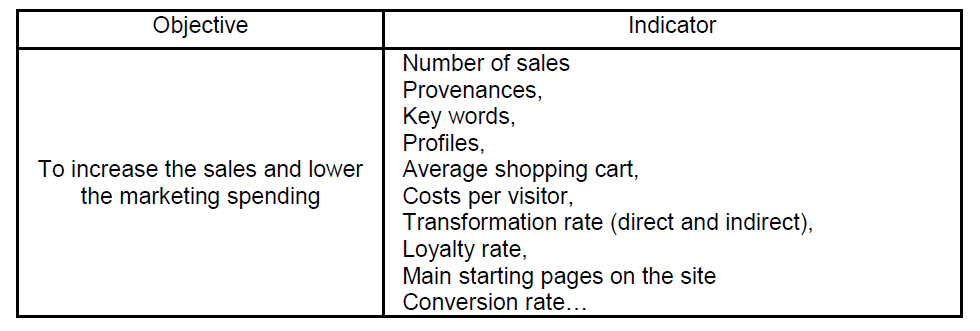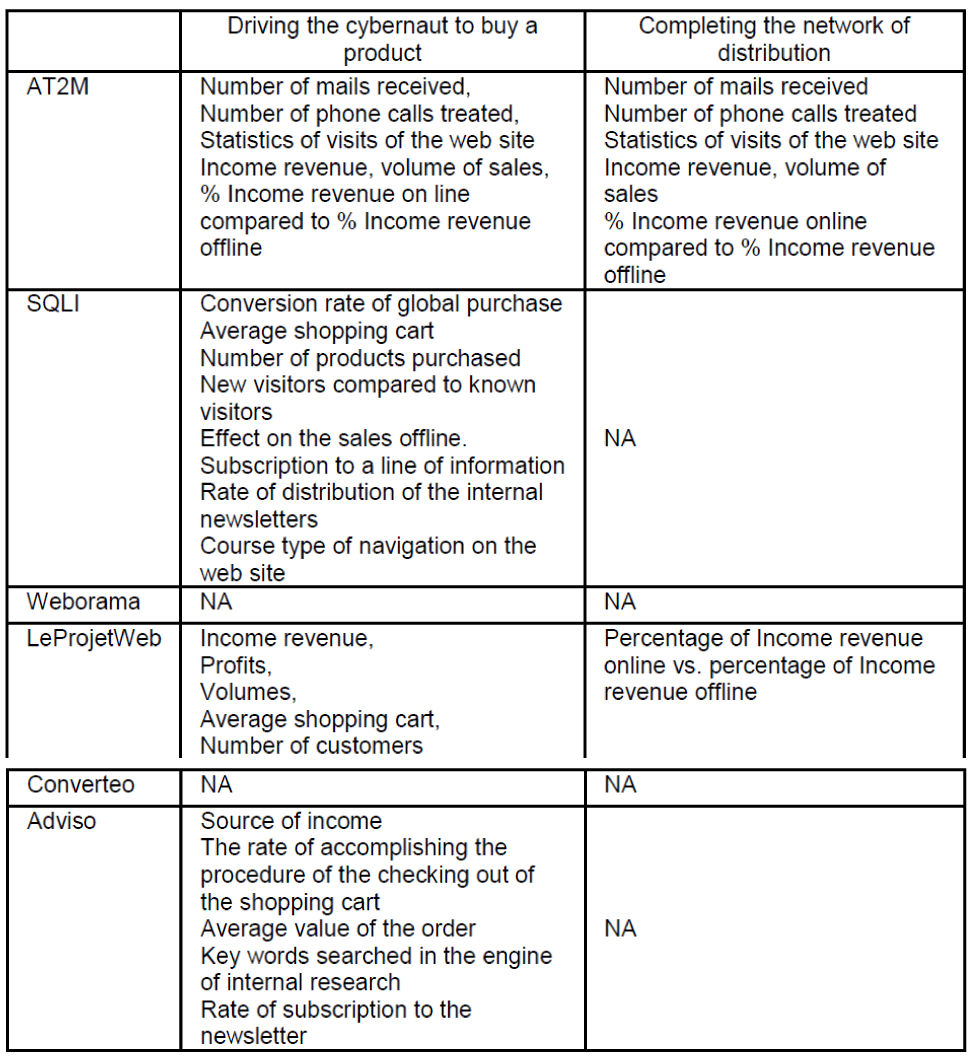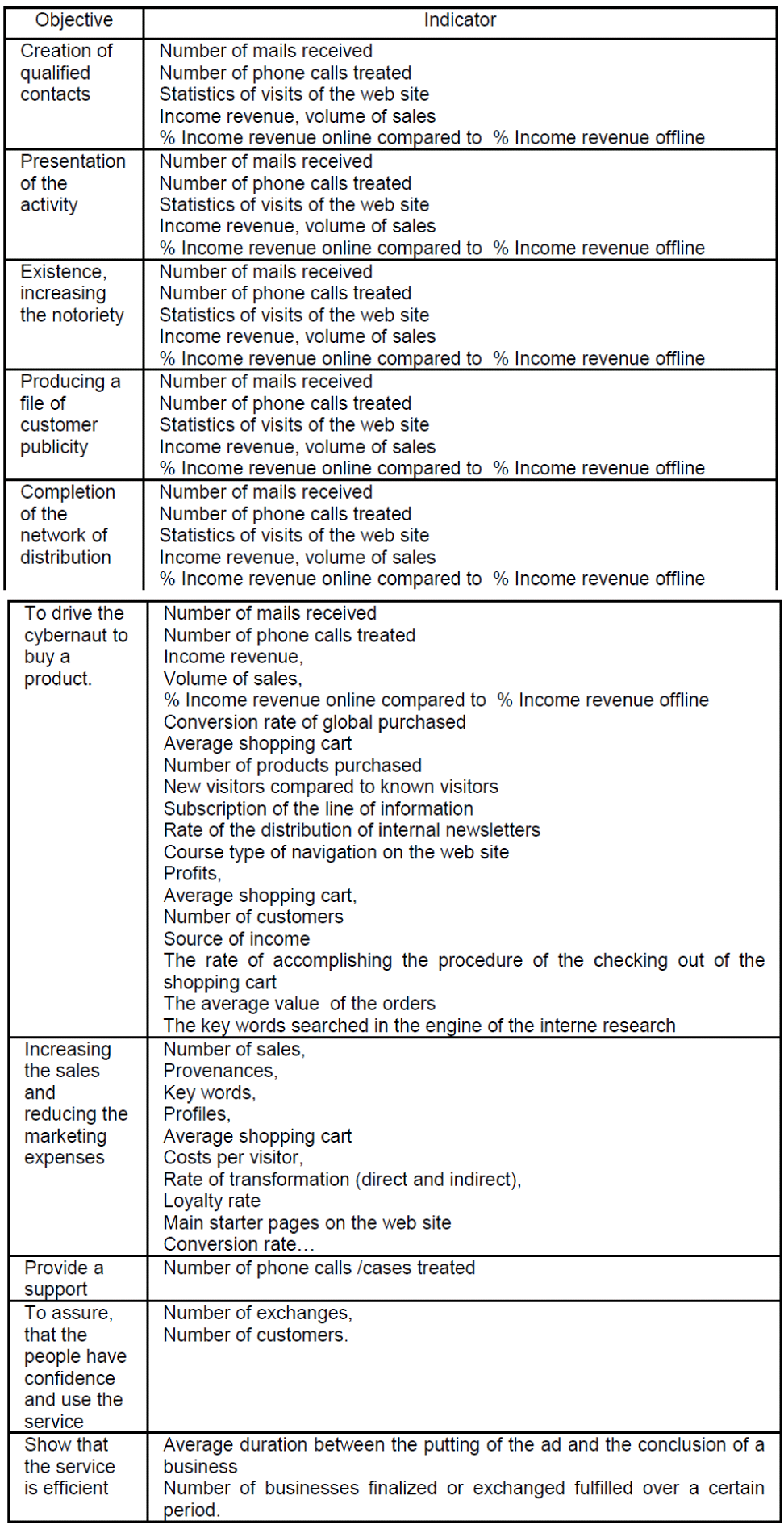ISSN: 1204-5357
ISSN: 1204-5357
Sébastien Bruyère
PhD student of sciences and project leader R&D within the web agency BleuRoy.com, University of Sud Toulon Var, France
Postal Address: 165, avenue du Prado, 13008 Marseille, France.
Author's Personal/Organizational Website: www.bleuroy.com
Email: sebastien.bruyere@imotic.fr
Mr Bruyère is currently preparing and working on a PhD in an establishment. The matter of subject is based on the management and know-how of the piloting and interpretation of e-marketing
Vincent Pillet
Technical director and R&D within the web agency BleuRoy.com
Postal Address: 165, avenue du Prado, 13008 Marseille, France.
Author's Personal/Organizational Website: www.bleuroy.com
Email: v.pillet@bleuroy.com
Pillet is the leader of the R&D center and the technical center of the agency Web BleuRoy.com. BleuRoy.com is an interactive agency which guides and accompanies the businesses and institutions, using internet and e-marketing as a solution to succeed.
Luc Quoniam
Professor at Université du Sud Toulon Var, France.
Postal Address: Avenue de l'Université, BP20132, 83957 La Garde cedex, France
Author's Personal/Organizational Website: www.univ-tln.fr
Email: quoniam@univ-tln.fr
Luc Quoniam, Professor at the University of Sud-Toulon-Var. He also is guest lecturer at the faculty of economics and administration (FEA) of the University of Sao Paulo and at the university Fernando Pessoa in Portugal. He is considered as an expert of the competitive intelligence and techniques of Web 2.0 in France.
Visit for more related articles at Journal of Internet Banking and Commerce
In France, with more than 19 billion Euros of production figures in 2007 (Source: Acsel), there is a significant boom in the e-shopping sector. Proof lies also in the results of the first trimester of 2008, showing that the results are better than those the years before. Many businesses decide to expand on their work by creating and setting up their own boutiques on line, but however quite quickly, the problem lies in the evaluation of the retour of investments, analyses of performances of the website and the evaluation of results. In able to do this, examples concerning the performance were established revealing the web indicators to follow in order to reach the strategic objectives qualified upstream. But these types of model have often been mixed together; certain have different vectors of communication and others simply have the indicators of Web Analytics. Coming from the protocol, we managed to produce a qualitative analysis of different models in order to establish a model of global theory.
Performance piloting, e-commerce, web analytics, ROI, Meta analysis
Today, the creation of an online shop is not a huge difficulty anymore. However, the piloting of the performance is more problematic.
The notion of performance is based on the action of the individual targeted through the media by opposition to a privileged approach to the exposition and visibility. On the subject of internet, it can be defined as in the ensemble of the allowances of marketing on line in which the results can be carefully measured and are reactivated starting from the analysis of the same results (Menajovski, 2006). Recently, thanks to different solutions of measuring the performance of knowing the actual business figures generated by the campaign, the notion of “measurability” allows us to evaluate the coast and acquisition and interest of a visitor or buyer and also by measuring the retour on investment of a publicity campaign.
But before investigating the measure of performance, it is necessary to clearly define the strategic goals to be reached (Naeem, 2006).
The notion of the objective defines a clear strategy with a cap to be reached. It can be distinguished by two types of objectives in measure of audience (Bathelot, 2006):
- The internal objectives are to measure the credibility of the web site itself as well as the action of promotion brought.
- The external objectives provide the audience data to potential partners of the enterprise for an eventual resale of space, as the web site is a potential support.
This notion of objective and choice of indicator for measuring seems to be mainly of general steps of analyzing the performance by the experts recognized in this domain. It is the case for the suggested Step-by-step guide by the community web portal Web-analytique .com (Naeem, 2006), of the SSII SQLI (Tessier, 2007) and the agency Weborama (Labus & Rodrigues, 2006).
But before finding the difficulty of putting the objectives into perspective and indicators which can vary in function of the typology of the web site, certain matrixes of assistance of piloting have been put in to place. Because of the diversity of the contents of the matrixes created by the experts, we were able to produce a Meta analysis planned to establish a model rich in reference.
In order to carry out our study successfully, we used different existing matrixes as a mean of a proactive research based on the collection of used resources by the e-business centre and different reading and research of the centre R&D. The majority of matrixes are often extracts of more global matrixes, others are a summery and adaption from articles of well known experts in the world of web analysis and e-business. They are all detailed compositions of objectives more and less fixed in function of the strategic attempts and indicators to follow in order to reach the targets.
For a second time, we looked to synthesize a model theoretically relevant to different matrixes studied in the form of a qualitative Meta analysis. The qualitative Meta analysis is a careful scientific step which is derived from the statistics of the analysis which puts the point on the question in the conditions of huge variety in the studies. In our case, we took distinct objectives in arbitrating on the occurrences sometimes subjective. From the objectives, we were able to agree on the different indicators of different models by eliminating the similarities.
None the less, we note that the definition of the objectives of the subject of e-business is still vague and imprecise. There are certain who speak of two categories of objectives (Menajovski, 2006):
- Objectives of volume like, for example, the number of sales made…
- Objectives of credibility via controlling the costs and ideally a retour on investment like the cost of acquisition, the ratio and budget spent/CA carried out.
For others, there is only one objective: notably the “Sell your product(s)” and more actions to fulfill in able to succeed like “helping” and “persuading” (Benett, 2007).
Concerning the indicators, it must be noted that there many techniques in order to obtain them:
- Either directly through the back office of the application e-business.
- Either via the application of Web Analytics through fixed markers on the web site pages.
- Either by the tool of promotion when it is about campaigns.
This distinction is important because the editor of the matrix can be influenced by the sphere of expertise in the proposition of his model.
The different methods:
• Model AT2M (Prat, 2007)
The model AT2M (Prat, 2007) is an extract of a matrix more general, it suggests numerous objectives without differentiating the indicators to follow in order for them to be reached. The Meta analysis will allow ventilation more precisely the indicators in function of the objectives.

• Approach SQLI (Tessier, 2007)
The model SQLI (Tessier, 2007) suggests only one objective and many indicators to follow. This approach is the same one suggested by Benett. This model is the extract of a typical model.

• Model Weborama (Labus, Rodrigues, 2006)
The model Weborama (Labus, Rodrigues, 2006) only suggests one objective and consequently is connected to the approach of the objective of Benett. It is also noticed that the suggested indicators are orientated Web Analysis. This is explained by the way that Weborama proposes another complementary matrix based on the communication.
The following example is an extract of a typical model.

• Model LeProjetWeb (Bordage, 2003)
The model « Le Projet Web » (Bordage, 2003) proposes different objects and indicators of an organized way. The following model is a typical example.

• Model Converteo (FÃÆétique, Duboz et Lendrevie, 2007)
The model Converteo (Fétique, Duboz and Lendrevie, 2007) arranges the e-business at the same level as the typology of the small advertisements. Thus the revelation of the indicators is mixed and is not always relevant. The following model naturally stems from a model more general.

Model Adviso (Choinard, 2008) in its presentation is however a devoid of objectives from the fact that it is specifically dedicated to the e-business, it can be imagined to be a one objective approach based on the sales of product as defined by Benett.

From the methodology proposed by establishing a Meta analysis (Delvenne, 2002) of different models suggested, we were able accumulate similar objectives between the different models.
The following table counts the different objectives and eliminates the repetition by models conforming to the procedure of the qualitative Meta analysis.

It seems that the notion of “sales” is presented on the virtual totality of the models. This can be explained by the fact that the sale on a web site of e-business is narrowly linked to its reason of being; the e-business is defined by the sales and purchases of products and by the services on the internet (Keeney, 1999). However, the matrix emerges the objectives more subtle like the valorization of the image, the creation of the base of contacts, the customer support, the setting up before the efficiency to distinguish the competition. Converteo does not see the need of the “sale of a product” and can be to distinguish itself by the optimization of the performance of e-business or by a separation not precise enough. Converteo proposes the same business model being for an e-business web site or for a web site of small advertisements.
Finally, two occurrences concerning the “complement to the distribution network of the business” have been found. This objective witnesses an emerging hybridization (Nguyen, Mevel, 2007) converging a sale of proximity and sale on line to equilibrate the resources of the enterprise. Naturally for this objective, the production figures have been taken into consideration and are primordial with a necessity of distinction between “online” and “offline” in order to pilot a global efficiency.
Parting from the only two objectives in common together with the matrixes, we were able to carry on our qualitative Meta analysis by rationalizing the indicators by pertinence and by eliminating the repetition.

It seems that the notion of « statistic of the number of visits » is too general to be accepted for the objective “Driving the cybernaut to buy a product”. The other occurrences excluded are the remarkable doubles.
Thanks to the previous results, it is at present possible to suggest a rich and pertinent model with the help of the performance piloting of the e-shopping web site.

The most developed model definitely proposes 10 objectives compared to 6 for the original model (Prat) mentioned at the beginning of the research. There are also huge chances that the Web Analyst in charge of the piloting of the e-business web site identifies the objective to be reached and consequently the indicators to follow and to be fulfilled.
Concerning the indicators, the objective of “sales” proposes a panel of 20 indicators against 8 for the original model at the start of the study (SQLI). It can also be said that our model of synthesis puts a monitor of 20 indicators from the web site into place in order to reach the main target and objective of a e-shopping web site (Benett, 2007).
As for the limits of the study, the original model Prat being the most complete in terms of need but unfortunately the most imperfect of them all concerning the ventilation of indicators, the final model can appear like one derived from the original model. It is one of the limits to the methods of the qualitative Meta analysis.
The objective of this document was to analyze different models and helpful examples of piloting of the e-business performance in provenance of diverse sources (Consulting offices, extracts of works…). In order to do this, we used the method of qualitative Meta analysis (Delvenne, 2002) which allows us to obtain a synthesis not necessarily perfect but more relevant than the original models. Between all the evolutions but at the risk of becoming more complex for piloting, the objectives of volume and credibility were categorized or even more, distinguishing the internal objectives from the external ones (Bathelot, 2006).
In the state of cause, we hope to have suggested along with other responsible e-business (or Web analyst), a way of help of piloting the performance being in coherence with the objectives to be reached via the revelation of following the indicators so that it leads to success.
Copyright © 2025 Research and Reviews, All Rights Reserved